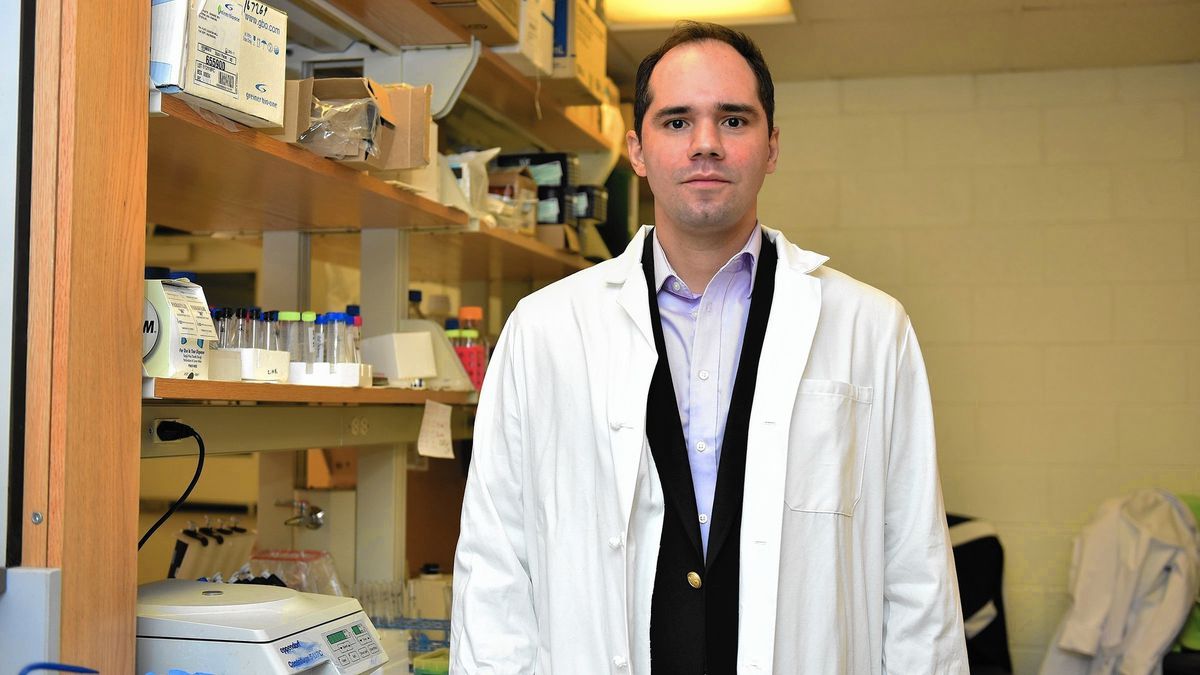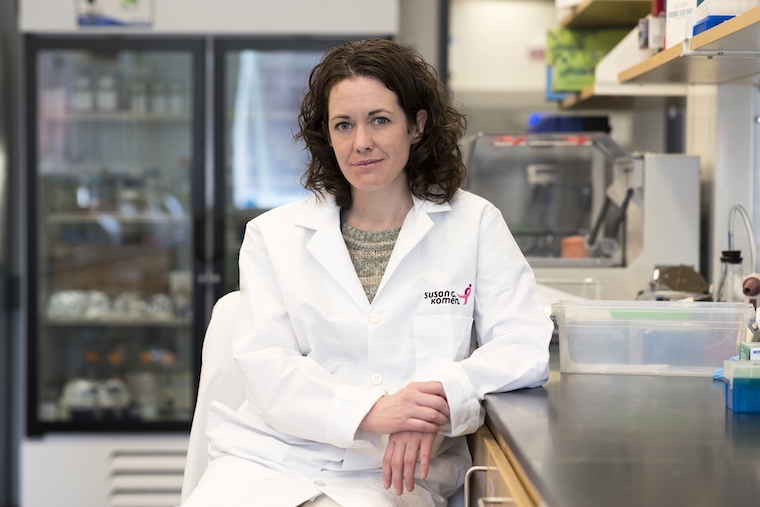Understanding the role of Lactobacillus in homeostatic and pathological conditions
Key Personnel: Andrea Merchak (second-year neuroscience graduate student), Courtney Rivet-Noor (of third-year neuroscience graduate student)
Summary: Multiple studies have demonstrated that the microbiome, specifically the collection of organisms inhabiting our digestive systems, have a profound impact on neurodevelopmental disorders, autoimmune diseases, and neurodegenerative pathologies, all of which are associated with Central Nervous System function. Using unpredictable chronic mild stress (an animal model of depression), the Gaultier lab has shown that a reduction in Lactobacillus correlates with behaviors associated with depression. They have also shown that therapeutic supplementation with Lactobacillus is sufficient to correct the observed signs of depression. The project aims to address a key gap in knowledge: How does microbiome dysbiosis drive depression? Specifically, this pilot project aims to understand the function of Lactobacillus in the context of stress and depression.
Establishing a model to examine the impact of a methanogen on enteric pathogen infections.
Key Personnel: John Satkovich (Lab Technician)
Summary: The human gastrointestinal (GI) tract harbors trillions of microbes that are collectively referred to as the microbiota. The resident microbiota play complex roles in human health. For example, the microbiota may effectively compete for nutrients against invading pathogens and thereby act as a barrier to limit or prevent infections. Conversely, certain members of the microbiota may enhance pathogen infection by producing metabolites that enhance growth and/or influence virulence gene expression. Because of the interplay between bacterial pathogens and the microbiota, manipulation of the microbiota may be an innovative means to treat infectious diseases. However, a more complete understanding of the specific roles of distinct members is required. To date, most studies have focused on microbes belonging to the domain Bacteria, which comprise the majority of microbes in the GI tract. Significantly, the microbiota is also comprised of microbes belonging to the domain Archaea. Of the Archaea, the methane-producing methanogens are the predominant members. Methanogens are present in the GI tract of nearly 100% of the world’s population and have been proposed to play an important role in human health and/or disease. Despite this fact, the functional contributions of methanogens to human health are virtually unexplored. The goal of Dr. Kendall’s pilot grant is to develop a model to assess the potential of methanogens to enhance or limit infection by invading pathogens.
PRIIIsM: Preterm Infant Inflammation and Intestinal Microbiome: Impact on the Brain
Key Personnel:
Summary: Inflammation and dysbiosis have been linked to brain injury in prematurely-born infants, who constitute 10% of all births and are at high risk of permanent neurodevelopmental impairment (NDI). Inflammatory insults commonly occur prior to or soon after preterm birth, critical time periods of growth and maturation when the brain is highly susceptible to damage. Increased understanding of the link between inflammation, dysbiosis, and NDI in preterm infants will lead to better methods for predicting, preventing, and treating brain injury in this vulnerable population, leading to more favorable long-term outcomes. The overall goal of the research proposed by Karen Fairchild’s team is to develop tools that can predict and mitigate neurodevelopmental impairment in NICU patients who are at very high risk for neurodevelopmental challenges (motor and intellectual and developmental disability, IDD). Prediction tools will be useful both for clinical care, tailoring specific therapies to the highest risk patients, and for research, stratifying patients into risk categories for clinical trials. Mitigation tools include neurorehabilitation programs starting soon after birth and continuing beyond NICU discharge. UVa NICU and trans-university researchers have funded collaborative projects aimed at improving motor, cognitive, and social/emotional outcomes of high-risk infants and children. We are establishing even broader collaborations across UVa grounds and with INOVA/Fairfax NICU/Pediatrics to expand the patient population and sociodemographic diversity. The team will use archived and prospectively collected samples from preterm infants <32 weeks gestation to identify biomarkers and physiomarkers of inflammation and stress and establish patterns of intestinal dysbiosis and metabolomics associated with inflammation and short-term NDI.
A Systems-Biology Approach to Understanding the Role of the Gut Microbiome in Modulating Susceptibility and Pathogenesis of Clostridioides difficile Infection
Key Personnel: Matthew Jenior Ph.D. (Postdoctoral Fellow)
Summary: Clostridioides (Clostridium) difficile is a Gram-positive, sporulating bacterial pathogen that causes a severe toxin-mediated disease, and has now become a prominent healthcare-associated infection. This work will utilize a systems biology approach to understand the metabolic signals from the microbiome that influences C. difficile colonization and virulence expression. In preliminary studies, the Papin Lab has applied integrative systems biology approaches to integrate omic data, allowing for in silico modeling of how environmental factors (the microbiome) influence C. difficile metabolic behaviors. By applying these methods to C. difficile infection, they will be able to highlight potential novel metabolic control mechanisms of pathogen colonization that are influenced by the behavior of the microbiota. The project proposes to begin systematic identification and testing of specific potential drivers of CDI progression across in silico, in vitro, and in vivo gnotobiotic platforms. The completion of this pilot project will generate functional insight into the metabolic properties of the gut microbiota that influence C. difficile metabolism and physiology, and create a predictive platform for mechanistic connections between the metabolism of the microbiota and pathogen, ultimately elucidating novel microbial drivers of recurrent C. difficile infection resolution.
Microbiota- & Metabolome-based Inflammation Biomarkers to Predict Neurocognition
PIs: Kevin Pelphrey, Ph.D. (UVA) and Suchitra Hourigan, M.D. (Inova)
Key Personnel: To be named Graduate Student
Summary: Early exposure to inflammation in infancy is increasingly recognized as a major factor hindering millions of children worldwide from meeting their full developmental potential. Previous studies link maternal, environmental, inflammatory, and socioeconomic factors to childhood neurodevelopmental outcomes. Understanding exactly how these factors interact to drive multifactorial neurodevelopmental outcomes is essential to our efforts to advance the diagnosis, prevention, treatment, and amelioration of intellectual and developmental disabilities (IDD). Neonates requiring intensive care at birth, particularly those born preterm, are at a very high risk of IDD. Neonatal Intensive Care Units (NICU) foster increased risk for infection and stress (and associated inflammation), and adversity more generally, with associated activation of the hypothalamic-pituitary-adrenal (HPA) axis and thus inflammation, even in the absence of infection. In a novel collaboration between the UVA School of Medicine (Kevin Pelphrey) and the Inova Health System (Suchitra Hourigan), the team will test the hypothesis that early, chronic inflammation in infancy sets the stage for atypical brain development, increasing the probability of the emergence of intellectual and developmental disabilities (IDD). We will determine whether shifts in the metabolome and/or microbiota occur prior to measurable inflammation and evaluate the extent to which these changes may provide biomarkers of IDD that will potentially serve as diagnostic indicators, predictors of treatment response, and quantitative treatment outcomes.
D-amino acid are chemical signaling molecules released by gut bacteria to modulate human brain physiology
Key Personnel: Alexis Apostolos (Dept. of Chemistry Ph.D. candidate)
Summary: The communication between the gut and the brain has been proposed to have a direct impact on human health, but the mechanisms by which this communication occurs is far less understood. One main class of bacterial metabolites, short-chain fatty acids (SCFAs), has been instrumental in establishing how chemical signals from organisms in the gut can be released to alter host physiology. While the discovery of SCFAs was seminal, it is likely that many more metabolites have yet to be discovered. Identifying these chemical signals can inform practices for improved human health and guide the discovery of novel therapeutic modalities to combat human diseases. The Pires lab proposes to evaluate a class of bacterial metabolites, D-amino acids, that could potentially modulate brain function. Intriguingly, one major source of D-amino acids in nature comes from bacteria, which utilize D-amino acids to build their cell walls. Recently, it was established that bacteria release large quantities of D-amino acids into their surroundings (reaching millimolar quantities), including into the guts of animals. In comparison, germ-free mice have undetectable levels of D-amino acids in their guts. The main hypothesis of this work is that D-amino acid (e.g., D-alanine and D-aspartate) are chemical signaling molecules that are released by gut bacteria to modulate human physiology. More specifically, D-amino acids modulate the function of NMDA receptors found, primarily, in nerve cells thus leading to modulation of brain function. This hypothesis is based on evidence that shows a subset of D-amino acids (e.g., D-serine and D-alanine) are well-established agonists of N-Methyl-D-Aspartate (NMDA) receptors, which are highly expressed in nerve cells. The dysfunction of NMDA receptors within the brain is associated with several brain-related disorders. The goal of the Pires pilot grant is to determine the link(s) between the microbiome and D-amino acids in the brain.
TLR5-mediated differences in the microbiome impair tumor growth and efficacy of PD-L1 blockade for ovarian cancer
Key Personnel: Tzu-Yu Feng (MIC Graduate Student), Mitchell McGinty (MIC Graduate Student)
Summary: High-grade serous ovarian cancer is the most lethal gynecologic malignancy and the fifth leading cause of cancer-related mortality in women, with nearly 14,000 deaths occurring annually within the United States alone. There is difficulty in treating the disease, but blocking tumor- or myeloid associated PD-L1 from interacting with the T cell inhibitory receptor, PD-1 has shown potential as a treatment. Even with this treatment, patients eventually succumb to the disease due to disease recurrence. One of the proposed mechanisms associated with ovarian tumor resistance to immune surveillance and immune checkpoint blockade is differences within the commensal microbiome. Previously, Dr. Rutkowski demonstrated that tumor-immune-mediated crosstalk between TLR5-expressing cells, through recognition of flagellated commensal bacteria, contributes to a loss of tumor immune surveillance during ovarian cancer. Furthermore, it was demonstrated that in the absence of TLR5 signaling, PD-L1 blockade results in robust and durable protection, achieving complete remission for a number of animals. Importantly, TLR5 knockout mice have a significantly increased survival advantage when rechallenged with the same tumor in the absence of additional therapy. Microbiome analyses show that the TLR5 knockout mouse microbiome is enriched in bacterial taxa that have been associated with response to PD-L1 blockade in other studies. On the other hand, wild type mice have microbiome enrichment of bacterial taxa associated with a diminished response to PD-L1 blockade. These data suggest that the TLR5 KO microbiome may influence responsiveness to PD-L1 blockade, likely by contributing to immune suppression within the tumor microenvironment, thus diminishing the response to PD-L1 blockade. The overarching goal of this work is to define the contribution of the microbiome and TLR5 expressing host cells during PD-L1 therapy in wild type mice with ovarian cancer. These studies would justify future investigations into microbiome-based therapies that are more capable of increasing the efficacy of PD-L1 blockade and also triggering powerful and long-lived anti-tumor immune responses against ovarian tumors.
Metabolomic impacts of TB and TB treatment among children
Key Personnel: Darwin Operario, Ph.D. (Senior Scientist) and Hardik Parikh, Ph.D. (Bioinformatics Research Scientist)
Summary: With hundreds of bacterial species, the human intestinal microbiome is involved in complex bi-directional relationships with the host to maintain growth, metabolism, and overall health. Increasing attention has been given to the mechanisms by which the intestinal microbiome can induce and produce metabolites that modulate host immunity. An array of commensal bacteria is essential for maintaining tolerance to certain microorganisms while conferring immunity to invasive pathogens. The production and trafficking of short-chain fatty acids, especially butyrate, by gut microbiota are key modulators of tolerance. Early infancy and childhood represent a critical time for the assembly of the gut microbiome, conferring effects on nutrition, development, and immune signaling. Inflammation, infection, or antimicrobial treatment can act as insults to the microbiome altering the diversity and abundance of certain flora, as well as the resilience of microbial populations.
Tuberculosis (TB) is the leading global killer from a single infectious disease, caused by the curable pathogen Mycobacterium tuberculosis. Although an estimated 24% of the global population–1.7 billion people— are latently infected with M. tuberculosis, only a fraction progress to TB disease.6 In 2018, an estimated 10 million people developed TB, including 1.1 million children. Those younger than 5 years of age have a higher risk for progression to active TB after exposure, which has been ascribed to the immature immune system. Treatment is lengthy, requiring 6+ months of rifampin, isoniazid, pyrazinamide and ethambutol.
How TB disease and therapy affects the human microbiome is understudied. There is growing evidence that potential cross-talk along the gut-lung axis can impact TB susceptibility, disease progression, and clearance. Although TB drugs are relatively narrow in antimicrobial spectrum, they impart specific and measurable effects on the microbiome. There is a paucity of literature concerning the effects of TB and TB therapy on the pediatric microbiome. Given that the human microbiome undergoes substantial development during the first two years of life, insults to the microbiome during this window carry immense potential to affect health, for example by altering nutrient metabolism thereby affecting long-term growth. Thus, the project's overall goal is to examine the gut microbiome from children with and without TB disease to identify how the composition and abundance of intestinal flora and metabolomic output are altered by TB disease and TB therapy over time.
The detection of a ketogenic diet-induced metabolic signature in a cohort of relapsing multiple sclerosis patients
PI: James "Nick" Brenton, M.D.
Key Personnel: Maureen Carey and Brett Moreau (Data Scientists)
Summary: Multiple sclerosis (MS) is an autoimmune neurodegenerative disorder and its course is influenced by environmental factors. Dietary intake is one environmental factor that modulates disease via direct influences on an individual’s immune profile and function – including shaping of the gut microbiome, development of the host immune system, protection against pathogenic organisms, and maintenance of the immunologic response. There has been a strong interest in therapeutic diet interventions for MS, yet the evidence base for a particular “MS diet” is currently lacking. One of the oldest diet interventions – a low carbohydrate, high fat diet known as the ketogenic diet (KD) –has several key characteristics that make it an ideal diet-based approach for disease modification in MS – including its anti-inflammatory properties and its ability to attenuate oxidative stress and enhance mitochondrial biogenesis. On a KD, MS subjects experience significant reduction in serum pro-inflammatory adipokines and exhibit significant clinical improvements in MS-related neurologic disability, fatigue, and depression. However, there remains a knowledge gap as to the mechanism(s) by which these benefits are promoted and sustained – including the impact of this diet on the human MS metabolome. This pilot project will take the first critical step in defining potential metabolomics mechanism(s) of a KD in patients living with MS. Identifying how a diet intervention could impact the disease process in MS patients - potentially by way of correcting a dysregulated metabolome - will provide great insight into the impact on the dietary and/or lifestyle management in MS patients.
Metabolic and microbial signatures associated with Cryptosporidium infection and diarrhea
Key Personnel: Catalina Alvarez (BME graduate student) and Carol Gilchrist, Bill Petri, and Rashidul Haque (Collaborators)
Summary: Cryptosporidium parasites are a leading cause of childhood diarrhea, but can also cause subclinical infections without enteric symptoms. We recently identified an association between the microbiome and diarrhea during Cryptosporidium infection. Specifically, we observed that Cryptosporidium diarrhea was inversely associated with the presence of Megasphaera, both prior to and at the time of infection, in a cohort of Bangladeshi infants. If the microbiome confers protection, it may act via altering the intestinal metabolome or host response, or by directly interacting with the parasite. We hypothesize that children with and without diarrhea during cryptosporidiosis have metabolic differences induced by the microbiota. This work will establish a putative metabolic mechanism for microbiome-mediated protection and garner further support for the role of Megasphaera in the subclinical phenotype.
Investigating the role of microbiota-driven intestinal immune responses in oral vaccine failure during undernutrition
Key Personnel: Jasmine Cano, B.A. and Yadeliz A. Serrano (graduate student)
Summary: Undernutrition and linear growth stunting in the first 1,000 days of life perturb metabolic and immune programming, with lifelong implications for health and productivity. This syndrome is multifactorial and intergenerational; mothers who experience growth stunting are more likely to give birth to stunted children. Intestinal pathogens are also common in undernourished communities and contribute to poor child growth. Rotavirus (RV) is the number one cause of childhood deaths from diarrhea, and oral Rotavirus vaccination (ORV) is significantly less effective in undernourished populations than in developed areas. The gut microbiota plays a pivotal role in shaping the development of both intestinal and systemic immune responses, and stunted children are known to have altered microbial communities and mucosal immunity. Preliminary data from our lab demonstrate that colonization of gnotobiotic murine breeding pairs with microbiota from a severely stunted infant transmits alterations in immune development to resulting pups (relative to offspring of animals with microbiota from a healthy child).
We propose to test the hypothesis that stunted offspring have reduced intestinal barrier integrity, leading to dysregulated IgA targeting of the microbiota and poor oral vaccine efficacy. The goal of this proposal is to determine the extent to which development of a successful oral vaccine response is influenced by mucosal immune recognition of the gut microbiota in early life, setting the stage for future investigation into bacterial functions and host pathways that regulate oral vaccine efficacy. This work is significant because improving oral vaccine efficacy offers an enormous opportunity to reduce deaths from childhood diarrhea. It is innovative because it leverages a new model of intergenerational undernutrition to investigate the influence of human microbial communities on host immunity, and translational by identifying potential microbial targets to enhance oral vaccine efficacy.
Metabolite-mediated progression of colorectal cancer by Enterotoxigenic Bacteroides fragilis
PIs: Todd Fox, Ph.D. and Mark Kester, Ph.D.
Key Personnel:
Summary: The long-term goal of this project is to develop better therapeutics strategies for colorectal cancer (CRC). CRC is the second most common cause of cancer-related mortality in the United States with the lifetime risk of developing CRC at 1 in 20. CRC development can be caused by a combination of host- and microbiota- dependent mechanisms. Symbiosis between the host and the gut microbiome is critical for intestinal health. Evidence supports that alterations in the microbiome contribute to the development of CRC. A key mediator in this may be the bacteria enterotoxigenic Bacteroides fragilis (ETBF). ETBF is a molecular subset of B. fragilis distinguished by the secretion of a pathogenic factor, the B. fragilis toxin (BFT). Increased detection of ETBF has been reported in patients with inflammatory bowel disease and in those with CRC. Evidence supports that ETBF induces CRC in mice through a BFT-dependent activation of inflammation and disruption of epithelial cell- cell interactions. However, there is much unknown about how ETBF leads to colon tumor formation. The objective of this proposal is to fill in gaps in this knowledge through (1) delineating the role of EBTF-induced glycosphingolipids (GSLs) metabolism on CRC in mice and (2) identifying the metabolic perturbations that correspond to ETBF-induced tumorigenesis in the colon. Drs. Fox and Kester have formed a synergistic team to complete the proposed studies and have extensive experience in metabolism and sphingolipid biology. This team is augmented by the expertise of Dr. Sears (John Hopkins), an expert in ETBF and CRC, as well as the resources of the TransUniversity Microbiome Initiative. The public health significance of this work is substantial as understanding the mechanism of how ETBF alters cellular and lipid metabolism will lead to the identification of novel drugable targets to combat CRC.
Microbial dysbiosis as a driver of neuroinflammation and pathology in Alzheimer’s disease
Key Personnel: Carrie Cowardin PhD, Carol Manning MD, Hannah Ennerfelt (NGP Graduate Student), Coco Holliday (Undergraduate Student)
Summary: Mounting evidence indicates that imbalances in microbiota composition (also known as dysbiosis) are major hallmarks of most human neurodegenerative diseases including Alzheimer’s disease (AD). While there have been exciting recent findings demonstrating that dysbiosis occurs in AD, it still remains to be determined if changes in microbiota landscape are a cause or consequence of AD. Therefore, the first major goal of this proposal is to directly interrogate a role for AD-associated dysbiosis in neurodegenerative disease progression. We also currently lack knowledge of how alterations in microbiota diversity can contribute to neurodegenerative disease at the mechanistic level. Recent studies in other non-AD models of neurological disease have begun to reveal that the microbiome can influence disease pathogenesis by modulating immune responses and/or metabolite production (i.e. the metabolome). Despite this, the impact of the dysbiosis seen in AD patients on immune responses and the metabolome has yet to be fully investigated. Therefore, we will next leverage cutting-edge single-cell RNA-sequencing (scRNA-seq) and metabolomics approaches to provide a comprehensive and unbiased assessment of how AD-associated dysbiosis affects immune responses and the metabolome in our human microbiota transplantation system. Our overarching hypothesis is that dysbiosis in AD patients causes dysregulation of immune responses and the metabolome and that this can ultimately lead to exacerbated neurodegenerative disease progression.
Successful completion of the proposed research directions will define to what extent AD-associated dysbiosis contributes to neurodegenerative disease pathogenesis and will also begin to reveal prospective factors underpinning the effects of the human AD microbiota on disease progression. If our overarching hypothesis is proven correct, this work would then be of translational significance, as microbiota targeting approaches such as fecal transplantation and probiotics could offer safe and cost-effective strategies to delay and/or treat AD.
Deep characterization of microbiota structure and function in kidney disease
Key Personnel: Jennie Ma, Pankaj Kumar, Binu Sharma, Shirin Pourafshar, Pao-Hwa Lin (Duke)
Summary: Kidney disease is a global health epidemic and one of the few non-communicable diseases rising in morbidity and mortality globally. The current standard to prevent kidney disease includes control of blood sugar, blood pressure, and body weight. The gastrointestinal (GI) microbiota is known to contribute to each of these risk factors, but its role in development of kidney disease is not well understood. Our goal is to evaluate the GI microbiota in individuals with mild-moderate kidney disease to identify candidate communities and functions that may contribute to pathogenesis. To achieve this goal we have established a pilot study cohort enriched with participants who have kidney disease. In this year-long longitudinal cohort, participants provide stool samples for microbiota characterization seasonally, dietary interviews throughout the year, health and medication information, and measurement of a variety of clinically important, kidney-related traits (blood pressure, body mass index, waist circumference, and glycemia). We will use stool shotgun metagenomic sequencing and LC-MS/MS metabolomics to identify candidate species and functions associated with kidney function and kidney-related traits to design a larger longitudinal follow up study.














